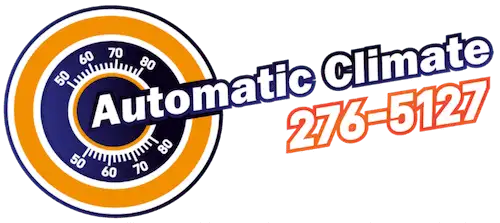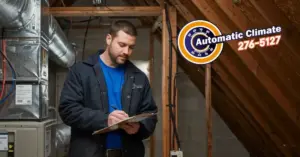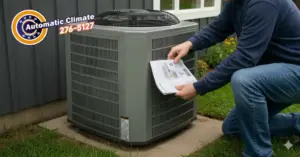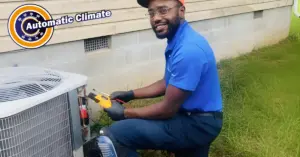How can I prevent mold growth inside my HVAC system?
Written by Cole Summers, HVAC Technician, Virginia.
One crucial goal for homeowners in Richmond, VA, and beyond is learning how to effectively prevent mold HVAC system growth. That musty smell creeping from your vents isn’t just unpleasant; it’s often a warning sign. Mold lurking within your heating, ventilation, and air conditioning (HVAC) system can compromise your home’s air quality and potentially impact your family’s health. Fortunately, proactive steps can significantly minimize the risk, ensuring your system circulates clean, healthy air. Understanding the conditions that allow mold to thrive is the first step towards achieving a successful strategy to prevent mold HVAC system issues before they start. As Benjamin Franklin wisely noted, “An ounce of prevention is worth a pound of cure,” and this absolutely applies to maintaining a healthy home environment.
At Automatic Climate HVAC & Air Conditioning, serving the Richmond community since 1983, we’ve seen firsthand the problems unchecked moisture can cause. Our extensive experience in HVAC services gives us unique insight into how to prevent mold HVAC system problems effectively. This comprehensive guide will walk you through the causes, risks, and most importantly, the actionable steps you can take.
Why Does Mold Love Your HVAC System?
Mold needs three basic things to grow: moisture, a food source, and darkness. Unfortunately, your HVAC system can inadvertently provide all three, creating an ideal breeding ground. Understanding these elements is key if you want to prevent mold HVAC system colonization.
The Critical Role of Moisture
Moisture is the single most important factor. It can accumulate in several areas within your HVAC system:
- Evaporator Coils: During the cooling process, condensation naturally forms on these cold coils. Normally, this moisture drips into a drain pan and flows away.
- Drain Pans & Lines: If the drain pan is cracked, improperly sloped, or the drain line becomes clogged with algae, slime, or debris, water can back up, creating stagnant pools perfect for mold. This is a frequent failure point we address to prevent mold HVAC system issues.
- Ductwork: Condensation can form inside poorly insulated ducts, especially those running through unconditioned spaces like attics or crawl spaces, when warm, humid air meets the cold duct surface. Effective strategies to control humidity mold are essential here.
- Humidifiers: While intended to add moisture, poorly maintained humidifiers connected to HVAC systems can become mold sources themselves.
Controlling this moisture is paramount to prevent mold HVAC system development.
Our Trusted Partners
EXCELLENTTrustindex verifies that the original source of the review is Google. Our tech, Simon is an absolute professional. Prompt, thorough and extremely knowledgeable. High performance work in a short amount of time, all while educating us on some basic HVAC know how to prevent long term issues. He is an asset to Automatic Climate, HIGHLY RECOMMEND!
Owner's reply
Thank you for your kind words! We're thrilled to hear Simon provided such excellent service and valuable HVAC knowledge. We'll be sure to share your feedback with him—it's great to know he's making a difference!Posted onTrustindex verifies that the original source of the review is Google. Thank you to Antonio Diaz for always being prompt, professional and diligent. He makes sure you understand what’s happening and why with your system. A+ for service!
Owner's reply
Thank you for recognizing Antonio's dedication and professionalism! We're thrilled to hear about your positive experience. Your feedback motivates us to keep delivering top-notch service.Posted onTrustindex verifies that the original source of the review is Google. Antonio is a great technician.
Owner's reply
Thank you for recognizing Antonio's effort! We’ll be sure to pass along your kind words to him.Posted onTrustindex verifies that the original source of the review is Google. Tech was very knowledgeable and professional. Recommended proper maintenance and repairs what was needed to keep our system running smoothly. Highly recommended.
Owner's reply
Thank you for your kind words! We're glad to hear our tech provided knowledgeable and professional service. Regular maintenance is indeed key to keeping systems in top shape. We appreciate your recommendation!Posted onTrustindex verifies that the original source of the review is Google. Ashante wa great! The experience with her visit was great. She called ahead of time to inform of her arrival time and proceeded to ask if I needed her to pick up a drink or water while she was en route to my house. During her inspection she was very informative and presented the options very clearly and wasnt forceful when presenting the options. Ashante was very pleasant the entire time. I would want her for all of my service visits! AC should are fortunate to have her with their company! Tye
Owner's reply
Thank you for sharing this wonderful feedback about Ashante! We're thrilled she provided such a positive and accommodating experience. We'll make sure to share your kind words with her.Posted onTrustindex verifies that the original source of the review is Google. I contacted at least 7 different companies and Automatic Climate was the ONLY one who called me back to set up a time. They were friendly at the office and Tevin did a great job in the field. He explained the process, fees, and showed me videos of the before/after when the work was completed. Since this original posting I have had a few other techs out for various issues (including most recently Najee). All have been pleasant and informative!
Owner's reply
Thank you for sharing your experience! We're thrilled to hear about your positive interactions with our team and the great work they've done. Your feedback motivates us to keep delivering excellent service.Verified by TrustindexTrustindex verified badge is the Universal Symbol of Trust. Only the greatest companies can get the verified badge who has a review score above 4.5, based on customer reviews over the past 12 months. Read more
Organic Matter: Mold’s Buffet
Mold feeds on organic materials. Inside your HVAC system, this “food” comes primarily from:
- Dust: Composed mainly of skin cells, fabric fibers, pet dander, and dirt – all organic.
- Pollen and Outdoor Debris: Pulled into the system from outside.
- Cellulose: Found in some types of duct lining or insulation materials if they become damp.
Regular cleaning and filtration are vital methods to starve potential growth and prevent mold HVAC system contamination.
The Advantage of Darkness
The interior components of your HVAC system – the air handler, coils, and ductwork – are mostly dark environments. Since mold doesn’t require sunlight (unlike plants), these dark, damp areas with a food source become perfect incubation spots. This highlights why vigilance is needed to prevent mold HVAC system problems.
Health Risks and System Damage from HVAC Mold
Allowing mold to grow in your HVAC system isn’t just an aesthetic issue; it poses tangible risks:
- Health Concerns: Mold releases spores and mycotoxins into the air circulated throughout your home. Exposure can trigger allergic reactions (sneezing, runny nose, itchy eyes, skin rash), asthma attacks, respiratory infections, and other respiratory problems, particularly in sensitive individuals, children, and the elderly. Prioritizing steps to prevent mold HVAC system growth is prioritizing your family’s health.
- Musty Odors: That characteristic damp, earthy smell is a common indicator of mold presence, making your home environment unpleasant. Eliminating the source is key.
- Reduced System Efficiency: Mold growth on evaporator coils or blower fan blades can impede airflow and heat transfer, forcing your system to work harder, consume more energy, and wear out faster. Diligence helps prevent mold HVAC system issues that cost you money.
- Component Damage: Mold and the associated moisture can corrode metal components and damage insulation or flexible ductwork over time.
Taking action to prevent mold HVAC system problems protects both your well-being and your significant investment in home comfort.
SKip The Line! Schedule Your HVAC Service by Booking Online Now.
Get in Touch
Contact Us
Understanding HVAC Mold: Causes & Effects
What Fuels Mold Growth?
Why is it a Problem?
Core Strategies to Prevent Mold HVAC System Growth

Now for the proactive part. Implementing the following strategies consistently is the most effective way to prevent mold HVAC system problems and maintain healthy indoor air quality.
1. Master Indoor Humidity Control
Since moisture is the primary catalyst, controlling indoor humidity is critical. Ideally, keep your home’s relative humidity between 30% and 50%. Here’s how:
- Use Your Air Conditioner Effectively: ACs naturally dehumidify as they cool. Ensure your system is sized correctly for your home – an oversized unit cools too quickly without removing enough moisture. Running it consistently during humid weather helps control humidity mold.
- Consider a Dehumidifier: In persistently damp areas like basements or crawl spaces, or during very humid seasons in Richmond, a whole-home or portable dehumidifier can be invaluable to prevent mold HVAC system issues linked to ambient moisture.
- Ventilate High-Moisture Areas: Use exhaust fans vented to the outside in bathrooms (during and after showers) and kitchens (while cooking) to remove excess moisture at the source.
- Check for Leaks: Regularly inspect roofs, plumbing, windows, and foundations for leaks that could introduce excess moisture into your home.
Effective moisture management is fundamental if you want to successfully prevent mold HVAC system growth.
2. Prioritize Regular, Professional HVAC Maintenance
Think of HVAC maintenance like car tune-ups – essential for performance, longevity, and preventing problems. Regular inspections and cleaning are arguably the most direct ways to prevent mold HVAC system trouble.
Routine HVAC maintenance mold prevention includes:
- Scheduled Tune-Ups: At Automatic Climate, our heating and AC tune-ups involve comprehensive checks. Technicians inspect and clean key components where mold often starts.
- Coil Cleaning: Evaporator and condenser coils should be cleaned annually. Dirty coils are less efficient and provide surfaces for mold to grow. This is a vital step to prevent mold HVAC system contamination.
- Drain Pan and Line Inspection/Cleaning: Technicians check for cracks, ensure proper drainage, and clear any blockages in the condensate drain line. A clean, freely flowing drain is critical to prevent mold HVAC system issues caused by standing water.
- Checking Ductwork Integrity: Inspections can identify leaky or poorly insulated ducts that might be prone to condensation.
Investing in a maintenance agreement ensures these crucial tasks are performed regularly, offering peace of mind and helping prevent mold HVAC system headaches.
3. Use High-Quality Air Filters and Change Them Regularly
Air filters are your first line of defense against dust and debris – mold’s food source.
- Choose the Right MERV Rating: MERV (Minimum Efficiency Reporting Value) indicates filter effectiveness. Filters rated MERV 8-13 offer a good balance between filtration and airflow for most homes, trapping dust, pollen, and mold spores. Higher MERV filters capture more but can restrict airflow if your system isn’t designed for them. Consult with a professional if unsure.
- Follow a Strict Replacement Schedule: This is non-negotiable to prevent mold HVAC system problems. Check standard 1-inch filters monthly and replace them at least every 1-3 months, or sooner if they appear dirty. Thicker media filters may last 6-12 months. A clogged filter restricts airflow, strains your system, and fails to capture contaminants.
Consistent filter changes are a simple yet powerful way to prevent mold HVAC system contamination by reducing its food supply.
4. Keep Components Clean
Beyond filters and professional maintenance:
- Registers and Vents: Regularly vacuum supply and return vents to remove dust buildup that could enter the system. Ensure they aren’t blocked by furniture or curtains, allowing for proper airflow. Sometimes visible signs of mold in air vents warrant professional attention.
- Outdoor Unit: Keep the area around your outdoor condenser unit clear of vegetation, leaves, and debris (at least 2 feet clearance). Good airflow is essential for efficiency and prevents debris from being drawn in. This supports the overall effort to prevent mold HVAC system issues.
Quick Guide: HVAC Mold Prevention Maintenance
Dealing with Ductwork: A Common Mold Hideout
Air ducts snake throughout your home, often hidden behind walls and ceilings. Their extended, dark surfaces make them prime real estate for mold if conditions are right. Addressing ductwork is often necessary to fully prevent mold HVAC system contamination.
Signs You Might Have Mold in Air Ducts or Vents
Be alert for these potential indicators:
- Persistent Musty Odor: A strong, earthy, or damp smell emanating from the vents when the HVAC system runs is a major red flag. This characteristic musty smell air vents often signal hidden growth.
- Visible Mold Growth: Dark spots or fuzzy patches appearing on or around air vents, registers, or sometimes visible inside the duct opening with a flashlight.
- Unexplained Allergic Reactions: If household members experience increased allergy symptoms (sneezing, coughing, itchy eyes) primarily when indoors or when the HVAC system is running.
- Condensation Issues: Noticing moisture or water stains on ductwork or around vents.
If you suspect mold, a professional inspection is the best course of action to confirm its presence and extent. This is crucial to effectively prevent mold HVAC system issues from worsening.
The Role of Professional Air Duct Cleaning
While routine filter changes help, sometimes ducts require a thorough cleaning. According to the EPA, duct cleaning may be beneficial if:
- There is substantial visible mold growth inside hard surface (e.g., sheet metal) ducts or on other components of your heating and cooling system.
- Ducts are infested with vermin (e.g., rodents or insects).
- Ducts are clogged with excessive amounts of dust and debris, and/or particles are actually released into the home from your supply registers.
Professional air duct cleaning by a reputable company like Automatic Climate uses specialized equipment (high-powered vacuums, brushes, air whips) to dislodge and remove contaminants. Importantly, addressing the underlying *cause* of the mold (usually moisture) is essential *before or concurrently with* cleaning to prevent mold HVAC system regrowth. Simply cleaning without fixing the moisture problem is often a temporary fix.
“The greatest discovery of all time is that a person can change his future by merely changing his attitude,” Oprah Winfrey once said. While she wasn’t talking about HVAC, adopting a proactive attitude towards maintenance can certainly change your home’s future air quality and help prevent mold HVAC system woes.
Considering UV Germicidal Lights
Ultraviolet (UV-C) germicidal lights are another tool in the arsenal to prevent mold HVAC system growth, specifically on surfaces like coils and drain pans. These lights emit UV-C radiation, which damages the DNA of microorganisms like mold, bacteria, and viruses, preventing them from reproducing.
- Placement: Typically installed inside the air handler unit where they can continuously irradiate the evaporator coil and drain pan – areas prone to moisture and mold.
- Effectiveness: They are most effective at preventing surface mold growth on components directly exposed to the light. They are less effective at killing airborne spores circulating quickly through the system or addressing mold already deep within ductwork.
- Complementary Measure: UV lights should be considered a supplement to, not a replacement for, fundamental practices like humidity control, filtration, and regular maintenance needed to prevent mold HVAC system issues comprehensively.
Discuss with an indoor air quality specialist at Automatic Climate whether UV lights are a suitable addition for your specific system and needs to further prevent mold HVAC system growth.
Ready to Prevent Mold HVAC System Issues in Your Richmond Home?
Don’t wait for musty odors or visible mold to appear. Proactive maintenance and inspection are key. The experienced team at Automatic Climate HVAC & Air Conditioning has been helping Richmond, VA homeowners breathe easier since 1983.
Let us help you implement strategies to effectively prevent mold HVAC system growth. We offer:
- Comprehensive HVAC Inspections & Tune-Ups
- Professional Air Duct Cleaning
- Indoor Air Quality Solutions (including dehumidifiers & UV lights)
- Reliable Maintenance Agreements
Or Call Us: (804) 803-1983
Case Study: Tackling Persistent Odors
Client: The Peterson Family, Richmond, VA
Problem: Persistent musty smell whenever the AC ran, despite regular filter changes. Increased allergy symptoms indoors.
Our Approach: An Automatic Climate technician performed a detailed HVAC inspection. Mold growth was discovered on the evaporator coil and in the drain pan due to a partially clogged drain line. Minor spotting suggested early mold in air vents near the handler.
Solution:
- Thoroughly cleaned the evaporator coil and drain pan.
- Cleared the condensate drain line and treated it to inhibit future blockage.
- Recommended and enrolled the Petersons in an annual maintenance plan to proactively prevent mold HVAC system recurrence.
- Advised on humidity monitoring.
Outcome: Musty odor eliminated. Allergy symptoms improved. The Petersons gained peace of mind knowing their system was clean and measures were in place to prevent mold HVAC system issues.
Advanced Considerations to Prevent Mold HVAC System Growth
Beyond the core strategies, a few more technical aspects play a role in the long-term goal to prevent mold HVAC system development.
Proper HVAC System Sizing and Installation
As mentioned earlier, an air conditioner that’s too large for your home (oversized) is a significant contributor to humidity problems. It cools the air very quickly in short, frequent cycles. While this might sound good, it doesn’t run long enough to effectively remove moisture from the air. This leads to a cool but clammy feeling and increases the risk of condensation – conditions favorable for mold.
Ensuring you have a correctly sized system, installed by qualified professionals like those at Automatic Climate, is a foundational step to prevent mold HVAC system issues related to poor dehumidification. When considering a new air conditioning installation, insist on a proper load calculation (Manual J) to determine the right size.
Sealing Air Leaks in Your Home and Ductwork
Air leaks in your home’s envelope (walls, windows, attic floor) and in your ductwork can disrupt humidity control and introduce contaminants.
- Building Envelope Leaks: Unsealed gaps allow humid outdoor air to infiltrate your home during summer, increasing the moisture load your AC must handle. In winter, they can let cold air in, potentially causing condensation on interior surfaces if indoor humidity is high.
- Duct Leaks: Leaky return ducts running through unconditioned spaces (attics, crawl spaces) can draw in dusty, humid, or potentially mold-laden air and circulate it. Leaky supply ducts lose conditioned air and can create pressure imbalances that worsen infiltration.
Sealing these leaks improves energy efficiency and helps maintain stable indoor humidity levels, contributing significantly to your efforts to prevent mold HVAC system problems.
Smart Landscaping and Grading
Believe it or not, what happens outside can affect your indoor environment and your ability to prevent mold HVAC system issues.
- Clearance Around Outdoor Unit: As mentioned, keep plants, mulch, and obstructions away from the condenser unit to ensure proper airflow and prevent debris intake.
- Proper Ground Slope: Ensure the ground around your foundation slopes away from the house. This prevents water from pooling near the foundation and potentially entering crawl spaces or basements, raising overall home humidity.
- Clean Gutters and Downspouts: Clogged gutters can cause water to overflow and saturate the ground near the foundation. Ensure downspouts direct water well away from the house.
Controlling external moisture sources reduces the burden on your HVAC system and helps prevent mold HVAC system growth indirectly by lowering overall home humidity.
As the famous architect Frank Lloyd Wright said, “Study nature, love nature, stay close to nature. It will never fail you.” While appreciating nature, we also need to manage its impact (like moisture) on our built environment to successfully prevent mold HVAC system troubles.
Taking these advanced steps, combined with the core strategies of humidity control, filtration, and regular HVAC maintenance, provides the most robust defense to prevent mold HVAC system problems for the long term.
Frequently Asked Questions: Prevent Mold HVAC System
Further Reading & External Resources
For more in-depth information from national sources on mold prevention and HVAC care, explore these resources:
- This Old House: How to Prevent Mold in Your Ductwork
- Consumer Reports: How to Prevent Mold
- Good Housekeeping: How To Get Rid of Mold in Air Vents
- Bob Vila: Solved! What to Do About Mold in Air Ducts
- The Washington Post: Musty smell? It could be mold in your HVAC system
- EPA: Mold and Moisture Prevention and Control Tips
Taking proactive steps is the best strategy to prevent mold HVAC system growth and ensure a healthy, comfortable home environment for your family in Richmond.
Our Trusted Partners
EXCELLENTTrustindex verifies that the original source of the review is Google. Our tech, Simon is an absolute professional. Prompt, thorough and extremely knowledgeable. High performance work in a short amount of time, all while educating us on some basic HVAC know how to prevent long term issues. He is an asset to Automatic Climate, HIGHLY RECOMMEND!
Owner's reply
Thank you for your kind words! We're thrilled to hear Simon provided such excellent service and valuable HVAC knowledge. We'll be sure to share your feedback with him—it's great to know he's making a difference!Posted onTrustindex verifies that the original source of the review is Google. Thank you to Antonio Diaz for always being prompt, professional and diligent. He makes sure you understand what’s happening and why with your system. A+ for service!
Owner's reply
Thank you for recognizing Antonio's dedication and professionalism! We're thrilled to hear about your positive experience. Your feedback motivates us to keep delivering top-notch service.Posted onTrustindex verifies that the original source of the review is Google. Antonio is a great technician.
Owner's reply
Thank you for recognizing Antonio's effort! We’ll be sure to pass along your kind words to him.Posted onTrustindex verifies that the original source of the review is Google. Tech was very knowledgeable and professional. Recommended proper maintenance and repairs what was needed to keep our system running smoothly. Highly recommended.
Owner's reply
Thank you for your kind words! We're glad to hear our tech provided knowledgeable and professional service. Regular maintenance is indeed key to keeping systems in top shape. We appreciate your recommendation!Posted onTrustindex verifies that the original source of the review is Google. Ashante wa great! The experience with her visit was great. She called ahead of time to inform of her arrival time and proceeded to ask if I needed her to pick up a drink or water while she was en route to my house. During her inspection she was very informative and presented the options very clearly and wasnt forceful when presenting the options. Ashante was very pleasant the entire time. I would want her for all of my service visits! AC should are fortunate to have her with their company! Tye
Owner's reply
Thank you for sharing this wonderful feedback about Ashante! We're thrilled she provided such a positive and accommodating experience. We'll make sure to share your kind words with her.Posted onTrustindex verifies that the original source of the review is Google. I contacted at least 7 different companies and Automatic Climate was the ONLY one who called me back to set up a time. They were friendly at the office and Tevin did a great job in the field. He explained the process, fees, and showed me videos of the before/after when the work was completed. Since this original posting I have had a few other techs out for various issues (including most recently Najee). All have been pleasant and informative!
Owner's reply
Thank you for sharing your experience! We're thrilled to hear about your positive interactions with our team and the great work they've done. Your feedback motivates us to keep delivering excellent service.Verified by TrustindexTrustindex verified badge is the Universal Symbol of Trust. Only the greatest companies can get the verified badge who has a review score above 4.5, based on customer reviews over the past 12 months. Read more











